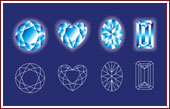

Diamond Shapes: Round Brilliant, Princess Cut, Pear, Heart
Round brilliant. This is currently the most popular and common diamond cut. A round cut diamond will look round when viewed from above. The most common round brilliant cuts have 58 facets, although some versions may have as many as 100. These are among the least costly to insure, as the cut is very stable and unlikely to cleave. Because round brilliants are currently the most in demand and draw out the most brilliance and fire of any other cut, they tend to be worth the most. A drawback is that a large portion of the uncut diamond has to be sacrificed to make a round brilliant. Modified brilliant. Modified brilliants come in many shapes and sizes, and are usually variations on the more common round brilliant cuts. A diamond cutter will typically decide to give a stone a modified brilliant cut if the rough shape is too irregular to produce a symmetrical round brilliant. Some variations include the heart; pear or drop; oval; the marquise, a narrow oval that resembles a football; and the triangle-shaped trillian. Step cut. Step cut diamonds are usually square or rectangular when viewed from above, with the sharp corners cut off to improve the stone's stability. The facets are also square or rectangular and arranged in steps from the top of the stone. Step cuts are not currently as popular as round and modified brilliants. Because the style results in a relatively shallow stone with fewer facets, step-cut stones are less brilliant and fiery. However, they highlight a diamond's clarity, color, and lustre–or surface reflection–very well, and less weight is lost in a step cut than in a brilliant. They are usually seen in antique jewelry, often of the Art Deco period. Variations include the Emerald and the Baguette cuts. Mixed cut. This style is designed to combine the best of both worlds: the fire and sparkle of the brilliants, plus the weight preservation, high clarity and lustre of the step cuts. The Princess is the most common mixed cut on the market, and is very popular. It has a high brilliance in comparison to other mixed and step designs. Most significantly, it preserves more of the original, rough diamond than any other type of cut. When viewed from the top, the Princess will be square in shape, with a network of complex diamond-shaped facets along the edges. Rose cut. This is a very old style that is believed to have originated in India, and is found often in jewelry dating to the Middle Ages. A rose cut diamond has a flat bottom and a domed top covered in triangular facets that meet at a point. It looks a bit like a disco ball when viewed from the side, although it is designed to resemble the petals of a rose. A rose cut diamond will usually have a soft, pleasant glow and an artistically sculptural shape. Because the flat bottom of this design does not present good depth, however, foil is often placed behind a rose cut diamond to artificially provide fire. Although round brilliants are often the most valuable diamonds, shape is only one factor in a series of qualities that determine a diamond's worth. As such, you may be able to find a single step cut diamond that's more valuable than ten round brilliants. Look for the diamonds that best suit your taste–whichever shape appeals to you most, you'll be able to find a high-quality diamond you love. Which is the best shape depends on personal taste and the proportions of the wearer, and we discuss this in more detail in our engagement ring advice page. Discover more about Diamonds: History, Diamond Jewelry, Engagement Rings, Quality, Carat, Color, Clarity, Cut and Shape. |
 The shape of a diamond isn't just a matter of taste. The right shape can add to a diamond's brilliance and fire, or can highlight its clarity and color. Some shapes preserve more of the original uncut diamond, giving you more stone for your money. In addition, some shapes are intrinsically more valuable than others. Following are a few of the more common diamond shapes on the market today.
The shape of a diamond isn't just a matter of taste. The right shape can add to a diamond's brilliance and fire, or can highlight its clarity and color. Some shapes preserve more of the original uncut diamond, giving you more stone for your money. In addition, some shapes are intrinsically more valuable than others. Following are a few of the more common diamond shapes on the market today.